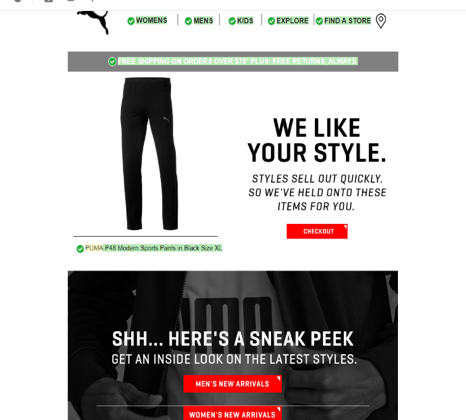Here’s something scary to think about.
While conversion rates vary by industry, on average nearly 98% of all visitors to your site will leave without making a purchase.
Most marketers focus solely on boosting their conversion rates, trying everything from modifying the content of landing pages, to increase ad spending.
And while improving the quality and frequency of your advertisements is a great way to boost revenue, targeting new visitors while ignoring those that have already visited your site is a common mistake made by marketers.
To truly boost your return on investment (ROI) you must implement smart retargeting campaigns.
What is Retargeting and What are its Benefits?
Retargeting is a form of online advertising that targets users that have previously visited your website. There are many reasons why retargeting is a successful and important marketing strategy. First, you are marketing to qualified leads – potential customers that have previously shown an interest in your products. Secondly, statistics confirm that brand familiarity greatly boosts your ROI. This is achieved through potential customers repeatedly interacting with your ads.
Statistics support the benefits of retargeting for increasing brand awareness. One study found that retargeting generated the strongest boost to brand familiarity among six different ad placement strategies. More specifically, the study found that retargeting generated a 1,046% boost in the number of business name searches.
Research also supports your customer’s notice and even enjoy receiving targeted advertisements.
According to CMO, nearly three out of five U.S. online buyers said that they noticed ads for products that were viewed on other websites. Approximately 25% of online customers enjoy retargeting ads because it reminds them of what they were looking at previously.
Here are some other interesting statistics about retargeting:
- Retargeting can boost ad response by up to 400%
- The average click-through rate (CTR) for display ads is 0.07% while the CTR rate for retargeted ads is 0.7%
- Website visitors who are retargeted with display ads are more likely to result in conversion by 70%
- Approximately 68% of marketing agencies and 49% of brands have a dedicated marketing budget for retargeting
So, if retargeting is not currently a part of your marketing strategy you are not only losing money, but your brand is also suffering.
How Does Retargeting Work?
There are some differences in retargeting across device types but as a general matter, the process works the same across platforms.
You work with a retargeting partner to place pieces of code on your webpage. Known as cookies or tags, these bits of code work silently in the background gathering information about each visitor to your website. The tags put together what are known as “intent signals”. Intent signals are data that show the actions people take online to identify products that each visitor is interested in.
Once the intent signals are identified, your retargeting partner will generate product recommendations for each user.
The user is exposed to the targeted advertisement and brought back to your website. While we will explore some of the differences between devices below, it is worth noting that a successful retargeting program targets both desktop and mobile users. Studies have found that somewhere between 41% and 65% of all online purchases originate on one device and are completed on another.
👋 A Note on the Differences Between Desktop and Mobile Retargeting
Desktop retargeting works by placing tracking tags or cookies on your web page, which we briefly mentioned above. The tracking technology itself is a form of JavaScript code that is inserted into your website’s source code. When your website is viewed, a tracking cookie is placed on the user’s browser. The cookie tracks the user’s browsing behavior and records important data.
The tracking cookies used by your retargeting partner are what are known as “third-party cookies”. The use of third-party cookies creates challenges for advertisers when attempting to engage in retargeting on a mobile platform. Since the browsers on mobile devices and tablets typically do not allow third-party cookies, it is very difficult to identify individual users. Without identifying individual users retargeting is less effective. This presents a real challenge for advertisers’ retargeting efforts since approximately 70% of all web traffic originates from mobile sources.
Large data companies have sought to remedy this problem through advanced techniques like deterministic matching across devices. Deterministic matching works primarily by identifying user ids and matching their use across devices to identify browsing behavior. While the science behind matching is beyond the scope of this article, it is a practice that you should be aware of if you are to successfully market to mobile users.
How to Use Retargeting to Boost Your ROI
Having explored the benefits of retargeting and some of the challenges of reaching mobile users, we now turn to specific strategies that you can use to start leveraging the power of retargeting. Before we do – make a mental note of the two-fold purpose of any retargeting campaign. First, you are seeking to boost awareness of your brand. Research shows that the more potential customers are exposed to your brand through targeted ads, the more likely they are to advance through the latter stages of your sales funnel.
Secondly, and perhaps most importantly, you want to boost conversions and drive up your ROI. The idea is that customers that are already somewhat familiar with your brand are more likely to make a purchase than new visitors. Choose the strategies that you think will work best for your existing sales funnel. Continually evaluate the progress of your campaigns and do not be afraid to discard or adopt new strategies until you find a winning formula.
The Major Retargeting Methods
There are many methods of retargeting, with specific strategies falling into each of these categories. The methods that we focus on here are:
- Website Based
- Behavioral
- Mobile
- Search
- List Targeting
The Most Common Form of Retargeting: Website Based Retargeting
Website based retargeting methods are what we had in mind when discussing desktop retargeting above. By using cookies you can monitor a user’s browsing behavior to gather important information about their likes and preferences. You have likely encountered this form of retargeting when adding an item to your shopping cart only to receive recommendations when visiting the site in the future.
Email Retargeting
Email retargeting works by sending follow-up communications to users that have opened an email from you. To be sure, email marketing is perhaps the most effective form of advertising, with some studies finding it to be upwards of 40x more effective than other forms of digital advertising like social media. However, the effectiveness of email retargeting campaigns is limited in a great deal by the practices of major email service providers that exclude tracking pixels.
That being said, email retargeting can still be an effective method, particularly when combined with other methods like web-based methods. For instance, you could redirect visitors to email landing pages in order to make use of tracking technologies.
👉 Winning Strategy in 2020: Behavioral Retargeting
Behavioral retargeting is a method that allows you to “customize” or “personalize” advertisements to each user. Through this method, you can remarket products that a specific user previously viewed. Perhaps more so than any other method of retargeting, behavioral retargeting saves you time. For ecommerce websites, retargeting is largely automated, importing data from your inventory into the advertisement being displayed.
Mobile Retargeting
We discussed the challenges that mobile traffic presents when retargeting above. To refresh, the inability to use third-party cookies on phones and tablets limits the ability to identify specific users. The best way to use mobile retargeting is through deterministic matching that serves advertisements across different devices. This way, a potential customer may view a product on your website and through mobile retargeting he or she can complete the purchase later through a phone or tablet.
Search Retargeting
Search retargeting works by looking at the specific keywords that a visitor used when finding and visiting your website. Once the keywords have been identified they are used to deliver related advertisements that are triggered by the keywords used in the search. For instance, suppose your online store sells sports equipment and apparel. A visitor arrived at your website by searching for running sneakers. A second visitor searched for Nike sneakers. If you were running a new sale for Nike running sneakers, for example, you could serve your advertisement on both visitors as the sale item is highly related to the visitor’s prior search history.
Other forms of search retargeting make use of search terms on third-party websites. While these users have not visited your website, you can identify the products and services that they are interested in, given their search history, and serve highly relevant targeted ads on these potential customers.
List Retargeting
In its simplest form, list retargeting involves sending retargeted ads to customers that have previously purchased a product from you. If your website has been in existence for a period of time, you may have acquired a large database of customers and their corresponding purchase history. This data is extremely valuable. Yet, many companies fail to engage their previous and/or existing customers, spending most of their marketing budgets on finding new customers.
List retargeting not only leads to repeat sales, but it presents an ideal situation for upselling and cross-selling your customers additional products and services. We discuss upselling and cross-selling in more detail later in this article.
But First…Some Basics
Before we get into the specifics of boosting your ROI through retargeting, there are a few things you should keep in mind.
First, make sure your website and advertisements are user friendly. Poor content and a bad user experience will generally result in low conversion rates and high bounce rates no matter how good your retargeting efforts are.
(By bounce rates, we are referring to the percentage of users that visit your site only to leave without clicking on another page or link. If your analytics suggest that many visitors are leaving your site, consider tightening up your content and improving user-friendliness before you go all in on retargeting.)
Content is typically poor where it is not relevant to those users that are reading it. Ask yourself who your customers are. What are their needs and interests? If you were visiting your website and/or landing page would you buy one of your products? It can be difficult to be objective when dealing with your own website so do not hesitate to ask a friend for an honest opinion.
User experience boils down to the look, feel and performance of your website. An unprofessional looking website featuring unattractive colors that takes entirely too long to load will never convert well.
Again, seek an honest and objective opinion about your website and make changes. (Or contact us for a quick assessment)
Once you have squared away your website, you need to invest a good deal of time into designing your ads.
Like poor content, a poorly designed ad will not lead to more sales regardless of your retargeting efforts.
A good advertisement should clearly and concisely communicate your offer. Your ad should be interesting and relevant to the potential customers they are being shown to. Most importantly, know what you are trying to achieve through the advertisement.
Are you looking to increase brand awareness to increase future sales? Or are you interested in immediate conversions through an attractive limited time offer?
Let’s look at two well-designed ads each with different intents. The first is for the workplace communication app, Slack.

This ad appeared on Facebook. The main goal of this advertisement is to increase brand awareness. Serving the ad on those that have previously expressed an interest in Slack, or a similar service, keeps the brand in the forefront of the potential customer’s mind.
Notice that there is no offer.
The ad clearly and concisely describes the benefits of Slack and gives the user an option to download the app, which is an ancillary goal of the ad.
Contrast Slack’s advertisement to this one from the New York Times:

This ad also appeared on Facebook. Unlike Slack’s ad, the intent of this advertisement is solely to increase sales. The ad clearly communicates the offer – an introductory subscription price of $1 per week – while also listing reasons why one should sign up for the New York Times.
This ad served on a user that has previously expressed interest in the New York Times or a general interest in current events and/or journalism, is a highly effective targeted ad that will lead to conversions. Finally, notice that both ads are simple, clean and feature a calm, attractive color scheme. Base your ad designs off similar templates to give your retargeting campaign the best chances to succeed.
Retargeting Strategies
Now that we have some background on retargeting, as well as some general marketing guidelines, let’s look at some of the more effective ways you can start using retargeting today to boost your ROI. Note that each of these strategies fall within the categories of the major retargeting methods that we discussed above. This list is not meant to be inclusive of all retargeting strategies. There are many ways to go about retargeting. Each of these techniques are widely used because they are so effective.
Offer Modification
We said at the outset of this article that some 98% of visitors to your website will leave without making a purchase. The reasons for this vary. A large percentage of your traffic is not at the point where they are ready to make a purchase. Or it could be that your offer is unappealing. Whatever the reason, modifying the terms of your offer often helps you to capture a portion of the 98% that did not purchase on the first visit.
Modifying the terms of your offer does not always mean slashing your prices more. Rather, change the content up and provide the user with something of value on the second go-around. For instance, if you offer a service, free informative content like an ebook or webinar, could help you to convert some new customers. Check out this retargeting ad from Drip:

Drip’s ad offers a free email marketing mastery course versus a discount from their services. This is an excellent offer modification retargeting ad for someone that has previously expressed an interest in Drip.
Up-Selling
An estimated 40% of all online revenue comes from repeat customers. Repeat customers are likely to spend 5x more that first time customers. Yet, as we mentioned above, many marketers fail to retarget their existing customers. Not only are they missing out on sales but failing to keep customers engaged will result in email lists going stale. Retargeting customers that have previously purchased products helps to pique their interest and get them to spend money.
Up-selling as a retargeting strategy is relatively simple. You offer more expensive products that are related to the products purchased by your customers in the past. For instance, consider this up-selling advertisement from Dropbox:

This advertisement is brilliant in both its intent and simplicity. The ad plays on the trust that a user has established with Dropbox through personal use. By offering a free trial for a business plan, Dropbox is upselling a potentially much larger and more expensive service simply by sending ads to existing users.
Cross-Selling and Down-Selling
Cross-selling is like up-selling but is designed to sell additional complementary products to those previously purchased. Cross-selling is particularly effective during the checkout process. Those of you that shop on Amazon are likely familiar with cross-selling. Amazon is great at suggesting complementary products when viewing items. For instance, here is an example of an Amazon cross-sell for some marketing books:

Not only is the customer shown titles highly related to his or her expressed interest, but packaging the books together gives the impression that one is getting a deal.
Down-selling is a method of selling products to customers that are not interested in the initial offer viewed. In other words, it is only appropriate to use down-selling where it is clear that a visitor is not going to buy what you are offering. A typical down sale occurs where the initial offer period has expired. For example, suppose you offered a marketing webinar scheduled on the first day of the following month. You could retarget those users that did not sign up for the webinar by offering a lower-cost product such as a transcript copy of the webinar. After all, selling something is better than selling nothing.
Abandoned Cart
Abandoned cart statistics are staggering. Consider the following:
- Each year some $4.6 trillion dollars are lost due to cart abandonment
- An average cart abandonment rate is approximately 76%
- Mobile users (77.8%) tend to abandon items in their carts more frequently than desktop (67.1%) or tablet users (70%)
- Among industries finance (83.6%), travel (81.7%), and retail (72.8%) have the highest abandoned cart rates
What all of this means is that items left in shopping carts are one of the biggest challenges that marketers face. Any successful retargeting campaign should focus on pushing a portion of these users further down the sales funnel into completing a purchase. Most e-commerce platforms have built-in features or plugins that can be installed to automate your abandoned cart efforts.
Here is a simple abandoned cart email we received from Puma after abandoning the purchase of a pair of sweatpants:

The email was sent under the subject “Nice cart”. Notice that is just a simple reminder. The email does not include a new offer, just a gentle urge that maybe all the customer needs to buy the pants (we did).
Your retargeting efforts should also be expanded to additional platforms. You could import your list of cart abandoners into a Facebook ad campaign, for instance. Companies like AdRoll and ReTargeter allow you to manage where your ads will appear – like Google or other social media platforms. By implementing all these channels you will boost your ROI.
Dynamic Retargeting
Dynamic retargeting works by sending personalized advertisements based on the user’s previous engagement with your site. This is largely accomplished through machine learning technology that analyses user behavior. Dynamic retargeting campaigns are generally more effective than static campaigns since they deliver more relevant ads to each user. They are ideally suited for ecommerce businesses with large product catalogs.
The best part about dynamic retargeting is that technology makes them incredibly easy to create and deliver. All you need to do is choose any dynamic retargeting partner – like Google, Adroll or Outbrain – and follow their instructions to install tracking tags in the correct location. Here is an example of a display dynamic retargeting ad showing the user some clothing items that had previously been viewed. These ads can appear on both your website or third-party sites.

Social Media Retargeting
The average social media user spends more than 2 hours per day on social media platforms. For this reason, marketers have increasingly turned to social media platforms to engage with their target audience. Social media retargeting works by serving ads on users after they have left your website. When a user visits your website, views a product, or adds an item to their cart, a cookie is installed on their browser. The cookie communicates the information to your retargeting partner. Relevant ads are then served on these users on social media platforms.
Throughout this article we have shown examples of effective ads. Many of these ads appeared on Facebook. Note that you can make use of many different strategies through social media retargeting. In addition to Facebook, Instagram, Pinterest and Twitter are highly effective options for reaching your audience.
Onsite Retargeting
Onsite retargeting has become increasingly popular as a solution to reduce high bounce rates. You likely encounter these ads frequently. They appear in the form of pop-up messages on a webpage. The technology works by analyzing a visitor’s real-time behavior and displaying relevant messages when the user is ready for them. A common tactic involves displaying an offer or attempting to capture a visitor’s contact information when the user moves the mouse towards the back button or page close button. The ad below offers a free report as a lead capturing tool. Notice that the ad is incredibly simple and offers the user something of value for simply inputting an email address.

Mobile Application
It is worth mentioning this category for two reasons. First, as we discussed earlier the number of mobile users is increasing exponentially. Second, this form of retargeting is slightly different from those we mentioned throughout the article which were geared more towards e-commerce and service-based sites.
For mobile app developers, it is not just about getting users to download an app. You want users to use the app since some 70% of mobile sales in the U.S. occur in-app. Not only that, mobile app users tend to spend more money and do so more frequently than non-app users. The problem is that users quickly lose interest after downloading the application. In fact, an estimated 1 out of 4 users stop using an app after install. Retargeting works to keep your mobile app users interested so that they continue to use your app and spend money.
Mobile app retargeting works by displaying relevant advertisements to users across applications. For example, suppose you are attempting to book a restaurant for the upcoming weekend using your favorite reservation app. You receive a call and are interrupted. When you pick up your mobile phone again you forgot that you had been looking for a table. Instead, you decide to play your favorite game. While you are playing your game an ad appears reminding you of your upcoming dinner. You click on the ad and are routed back to the app to complete your reservation.
To Sum it All Up…
If you are not currently engaging in some form of retargeting you are missing out. Approximately 98 out of 100 visitors to your website is leaving without making a purchase. Failing to follow up with them and bring them back to your site costs you money. The good news is that getting started with retargeting is fairly simple. There are many retargeting strategies that you can choose from depending on your business model and budget.
We have discussed some of our favorite commonly used retargeting strategies throughout this article. Try implementing some of these strategies in your marketing campaigns. See what works and what doesn’t. Through trial and error you will find a winning retargeting formula that will significantly boost your ROI and change the acquisition costs of your business. Feel free to contact us if you have any questions about the strategies mentioned in this article or for other questions related to retargeting, we are happy to help.

